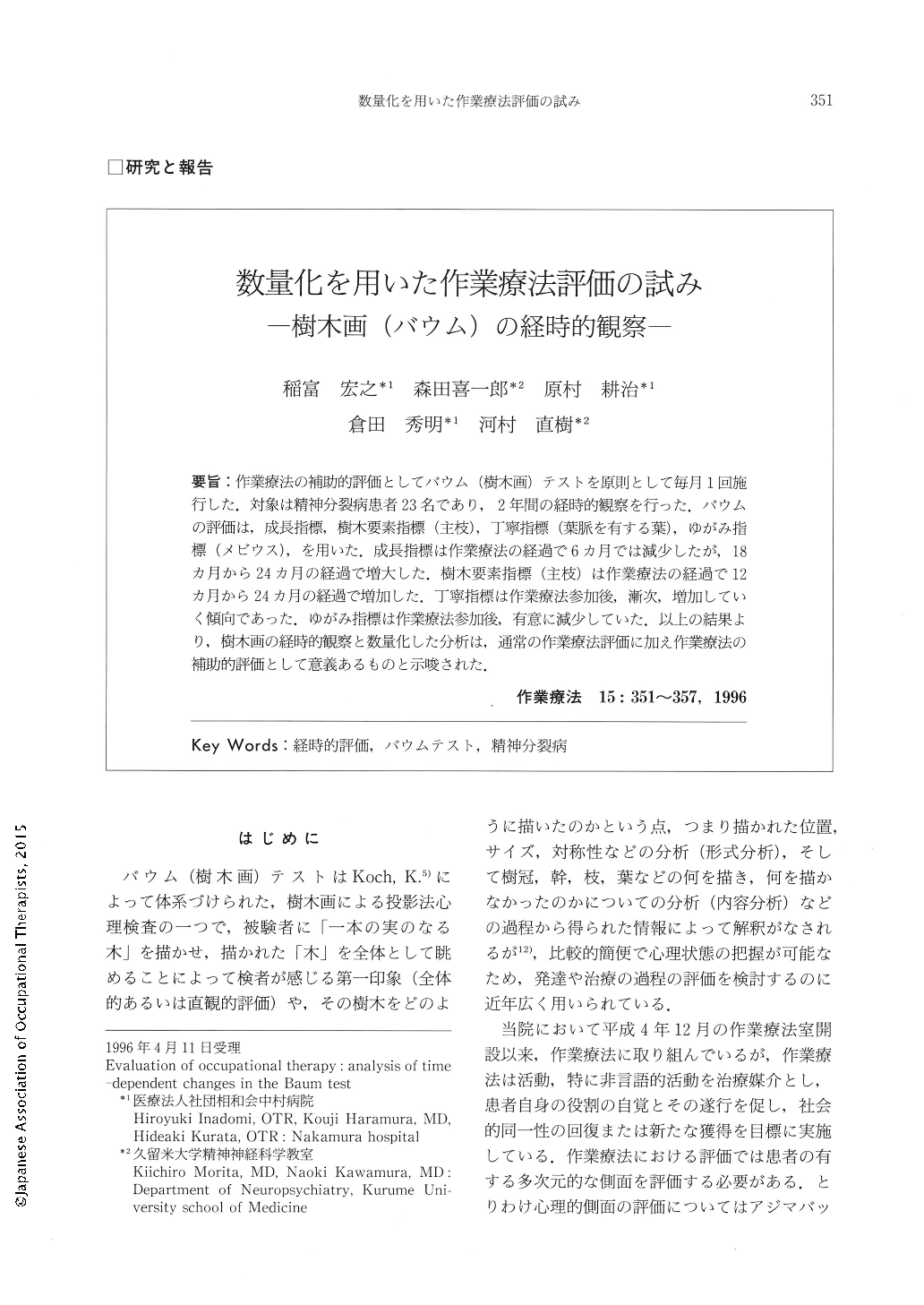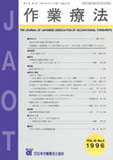Japanese
English
- 販売していません
- Abstract 文献概要
- 1ページ目 Look Inside
- 参考文献 Reference
- サイト内被引用 Cited by
要旨:作業療法の補助的評価としてバウム(樹木画)テストを原則として毎月1回施行した.対象は精神分裂病患者23名であり,2年間の経時的観察を行った.バウムの評価は,成長指標,樹木要素指標(主枝),丁寧指標(葉脈を有する葉),ゆがみ指標(メビウス),を用いた.成長指標は作業療法の経過で6カ月では減少したが,18カ月から24カ月の経過で増大した.樹木要素指標(主枝)は作業療法の経過で12カ月から24カ月の経過で増加した.丁寧指標は作業療法参加後,漸次,増加していく傾向であった.ゆがみ指標は作業療法参加後,有意に減少していた.以上の結果より,樹木画の経時的観察と数量化した分析は,通常の作業療法評価に加え作業療法の補助的評価として意義あるものと示唆された.
It is well known that the Baum test is easy to perform, causes little stress in the subject, and projects the subject's mental interpretation. The present study was performed to evaluate occupational therapy by using the Baum test. Occupational therapy (OT) was performed in an OT room for 2 years involving 23 patients with schizophrenia (7 : male and 16 : female) ; OT included several occupational tasks-for example, cooking, sports, and industrial arts. OT was evaluated by the rate of attendance at OT. The Baum test was also carried out for 2 years at intervals of about 1 month. Informed consent was obtained for each test from all subjects. The subjects were instructed to "Draw carefully one tree which grows fruits" as in the basic Koch method. To perform the Baum test, we measured several indices such as the growth index, tree-factor index (branch, leaf and fruit), and distortion indices (mebius and top -width of trunk). The growth indices involved the ratio of the tree-crown height to the tree-height. The branch index was calculated by counting the numbers of single-lined and double-lined branches coming only from the trunk. The polite index involved the number of leaves with veins. The distortion index was evaluated by the mebius and the ratio of the top-width of the trunk to its bottom width.
The rate of attendance from OT's beginning progressively increased. After six months, the rate grew to about 65% and, after one year, grew to about 85%, and was sustained for over 2 years. The growth index of the Baum test significantly decreased six months after the start of OT but progressively incresased for 2 years thereafter. There was a significant difference between the pre-OT value and those at one and a half years, and 2 years after the start of OT. There was no significant difference in the growth index between healthy subjects and schizophrenic patients (after 2 years of OT). There was no significant difference in the tree factors between schizophrenic patients (after 2 years of OT) and healthy subjects. In detail, the number of double lined branches increased significantly with time after the start of OT, but the number of single lined branches did not. The distortion indices decreased significantly with the duration of OT. To evaluate the learning (repetition) effect of the Baum test, the duration of OT and several indices were calculated. There were statistically significant differences between the correlation coefficients of repetition and those of OT duration.
These results, which time, strongly indicated significant improvements in several indices of the Baum test. The correlations between several indices and the duration of OT were higher than those between some other indices and the repetition of the test, indicating that the present changes in the Baum indices may be mostly due to the efficiency of OT. In consideration of these results, we concluded that the Baum test may be a useful tool and that this method should be used for additional evaluation of OT. We hypothesize that the Baum test may be useful for over all judgment of the efficiency of OT for improving schizophrenia.

Copyright © 1996, Japanese Association of Occupational Therapists. All rights reserved.


